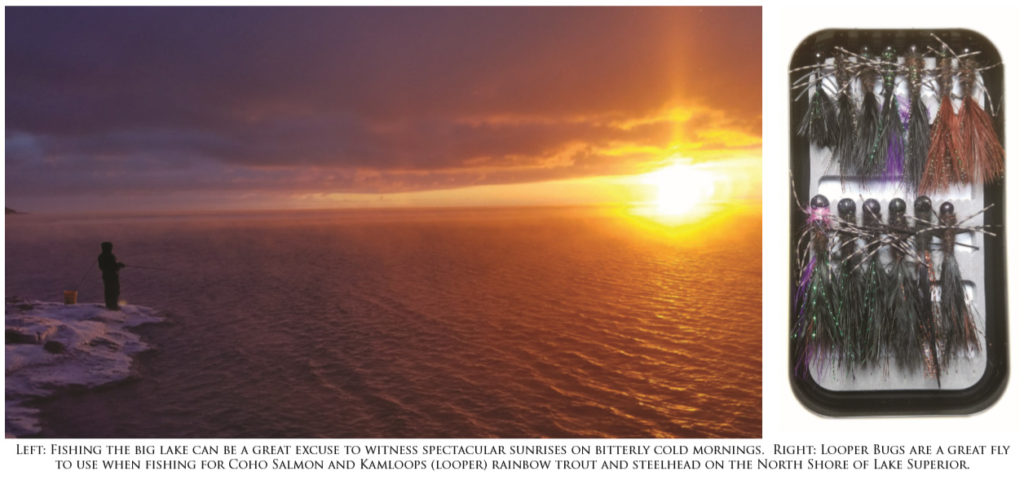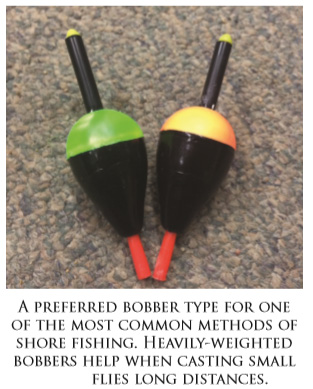Shore Fishing Lake Superior
by Jason Swingen

If you are like me, you love catching trout and salmon, but waiting through the long winter months for the rivers to break free can have you going stir-crazy. It may be time for you to try out a new type of fishing: shore fishing on the North Shore of Lake Superior! There are great opportunities to catch trout and salmon on the shore starting in the fall and continuing into the spring steelhead run.
Four years ago, my friend Ben sent me a text saying we should try shore fishing on Lake Superior. At first, I was skeptical that we would catch any fish from shore on the world’s largest freshwater lake, but I was willing to entertain the idea. Ben came up the next morning and we tried fishing for whatever we could catch. Just as the sun started to rise, Ben hooked a fish. Every few seconds we could see it jumping out of the water in the first rays of sunlight coming across the lake. At that point, I knew I was hooked.

By the end of this article you will have way more knowledge about shore fishing than I had starting out, including a good idea of what species you can expect to catch, when and where to target them, and all the equipment, flies, and tackle you will need to have a great day on the shore.
Species of Fish in Lake Superior
There are many species of fish in Lake Superior that you can catch from shore. The most popular fish targeted by shore anglers are steelhead, Kamloops rainbow trout (also called “loopers”) and coho salmon.
Equipment
You can use nearly any type of fishing rod. However, if you want to increase your chances of catching and landing a fish, then it is a good idea to buy a dedicated shore rod. Having a long rod (10-12ft) will allow you to cast further and get better hooksets. It is also important to have a rod with large guides that won’t freeze up in the winter. You’ll also want to pair your shore rod with a reel that has a large arbor, large line capacity, and a smooth drag. You can get away with any 200 size spinning reel, but the larger 300 to 400 sizes are ideal. These larger reels often have a better drag and hold more line.
The majority of shore anglers use 4-8 lb monofilament. Monofilament is cheap, it floats (which is ideal for bobber fishing), and has enough stretch to soften some of the violent head shakes and rolls of the bigger fish you will be catching. Tying on a swivel and fluorocarbon leader can also be a good idea especially when the water is extremely clear. Along with your typical fishing gear, don’t forget your ice cleats, head-lamp, sunglasses, and a long-handled net. It can get bitterly cold and icy on the shore, so dress like you are going ice fishing.
Techniques
There are many different ways to catch fish on the shore, including bobber fishing, casting spoons, and bottom-rigging. You can pick a certain technique or try them all and see which one catches the most fish.
Bobber Fishing – Bobber fishing is one of the most common ways to catch salmon and steelhead from shore. Heavily weighted bobbers allow you to launch your fly out to where the fish are feeding. These bobbers come in 3-4 different sizes. You may have to buy a couple of different sizes to see what ones match up the best with your rod. Rigging for bobber fishing is fairly simple, just peg your casting bobber onto your line two to four feet from the end of your line and tie on a fly or looper bug. Just like trout fishing on a river, you need to be quick with your hooksets. Since these bobbers are bigger than a typical strike indicator, they don’t always drop completely below the water. If you notice any odd wobbles or erratic movement of your bobber, set the hook!
Looper Bugs are a great fly to use when fishing for coho salmon and Kamloops (looper) rainbow trout and steelhead on the North Shore of Lake Superior. You can buy them in many of the local shops, but they are also very easy to tie. All you need is a jig hook and a couple of different materials including marabou, flashabou, dubbing, and rubber legs. If you can tie a woolly bugger, you can tie a Looper Bug. They can be bought or tied in a variety of sizes and color combinations. I prefer darker colors including black, brown, and purple (especially in muddy or wavy water). Loopers and steelhead will often take a plain Looper Bug, but if you are trying to catch a coho it is best to tip your fly with some meat (like a waxworm or butterworm). Midwinter and muddy water conditions are the best times to bobber fish with Looper Bugs.
If you fly fish or tie your own flies you can use your standard trout flies to fish from shore as well. Stoneflies and nymphs, including the Prince Nymph and Pheasant Tail Nymph, are go-to flies in almost any body of water, including Lake Superior. These flies, tied anywhere from size 6-16 can produce fish. As spring starts warming the water, or if the water is fairly clear, you will want to tie on a fly instead of a Looper Bug. Casting Spoons The first fish I caught from shore was with a casting spoon. I love catching fish with spoons because you are able to feel the fish hit. Once you cast, count down a couple of seconds, then start to reel with a fairly quick and constant retrieve (one to two revolutions per second). Some of the most popular spoons are Kastmasters, Lil’ Cleos, and Krocodiles. Start with a few 1/4 to 3/4-ounce spoons in orange/gold or blue/silver. Spoons can be a great way to catch fish in the fall, winter, or spring. From my experience, you are most likely to catch lake trout and steelhead in the fall, coho in the winter, and loopers in the spring.

 Bottom Rigging
Bottom Rigging
When bottom rigging, you can use a standard sinker or you can try the popular slinky rig (a sinker built out of parachute cord and split-shot). To get this system rigged up you’ll first want to slip your main line through the swivel of the slinky rig. Then tie on another larger swivel. Finally, tie on a two to four-foot section of leader and your preferred hook. Slipping your line through the first swivel will allow a fish to run without it feeling the weight of the sinker or slinky rig. Most anglers will fish this setup with spawn bags, but you can also catch fish with a simple worm. If you fish with a worm, you will either need a worm blower to make the worm float or you will need to add a small float to your leader. After you make your cast, place your rod in a rod holder (which can easily be built by duct taping PVC pipe to a metal rod). After your weight sinks to the bottom, slowly reel in the slack until your rod begins to bend. Late winter and spring are typically the best times to fish with bottom rigs.
Where to Fish
If you can make it down to a public section of shoreline, throw a line in! There are opportunities to fish all the way from Canal Park all the way up the shore into Canada. Some of the best areas to fish are near river mouths and from breakwalls. Just make sure you get to the lake early in the day or stay late. Most of the action happens near dawn and dusk. Keep an eye on the weather, the big lake can go from crystal clear and dead calm to muddy and crashing waves within a few hours. If the wind has blown hard the waves can make it difficult to drift a bobber or bottom rig. Dead-calm days can make for unnatural presentations when bobber fishing. In the dead of winter, a lack of wind can cause the shore to freeze over, making fishing from shore a frustrating task. Now you have enough information to get started, just make sure you check out the latest regulations from the MNDNR, then get out there and catch some fish!

